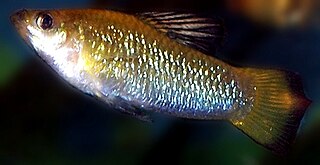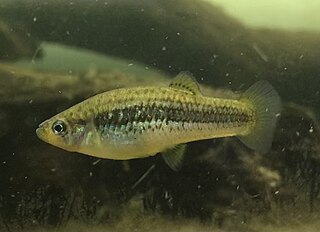
The western mosquitofish is a North American freshwater fish, also known commonly, if ambiguously, as simply mosquitofish or by its generic name, Gambusia, or by the common name gambezi. Its sister species, the eastern mosquitofish is also referred to by these names.

Gambusia is a large genus of viviparous fish in the family Poeciliidae. Gambusia contains over 40 species, most of which are principally found in freshwater habitats, though some species may also be found in brackish or saltwater habitats. The genus Gambusia comes from the Cuban term, "Gambusino", which means "free-lance miner". The type species is the Cuban gambusia, G. punctata. The greatest species richness is in Mexico, Texas, and the Greater Antilles, but species are also found elsewhere in the eastern and southern United States, the Bahamas, Central America, and Colombia. Gambusia species are often called topminnows, or simply gambusias; they are also known as mosquitofish, which, however, refers more specifically to two species, G. affinis and G. holbrooki, which are often introduced into ponds to eat mosquito larvae. As a consequence, they have been introduced widely outside their native range, and frequently become invasive, threatening local species. They are only occasionally kept in aquariums, due to their relative lack of color and the highly aggressive nature of the aforementioned mosquitofish species.
The widemouth gambusia is a species of fish in the family Poeciliidae of the order Cyprinodontiformes. It is endemic to Mexico, specifically to the Baños del Azufre near Teapa, Tabasco. The Baños del Azufre are sulfidic springs that contain high concentrations of toxic hydrogen sulfide. This prevents most animals from living in them; the only other fish found in the toxic sections of Baños del Azufre is the sulphur molly.

Lake Enriquillo is a hypersaline lake in the Dominican Republic located in the southwestern region of the country. Its waters are shared between the provinces of Bahoruco and Independencia, the latter of which borders Haiti. Lake Enriquillo is the largest lake in both the Dominican Republic and Hispaniola, as well as the entire Caribbean. It is also the lowest point for an island country.

Limia is a genus of livebearing fishes belonging to the Cyprinodontiform family Poeciliidae, which includes other livebearers such as platys, swordtails, guppies and mollies. They are found in fresh and brackish water. Of the 21 described Limia species, 17 are endemic to Hispaniola, one is found on both Hispaniola and Jamaica, and the Cayman Islands, Cuba, and Venezuela have an endemic species each. Limia are popular in aquaria among more advanced hobbyists.
The San Marcos gambusia is a likely extinct species of Gambusia from the family Poeciliidae that was found only in the San Marcos Springs of Central Texas. The fish has not been seen since 1983. The specific name of this fish honors the American ichthyologist George S. Myers (1905–1985).

Perugia's limia is a small fish of the family Poeciliidae endemic to the Caribbean island of Hispaniola, where it occurs in streams.
The yellowfin gambusia is a species of fish in the family Poeciliidae. It is endemic to the Rio Conchos of Chihuahua, Mexico, where it is known as guayacon de san gregorio. This species was described in 1957 by Clark Hubbs and Victor G. Springer with the type locality given as El Ojo de San Gregorio in Chihuahua. The specific name of this fish honours the Mexican ichthyologist José Alvarez del Villar (1903-1986) for his work on the fishes of Mexico and for his assistance to Clark and Springer.

Gambusia hurtadoi, also known as crescent gambusia, is a species of fish in the family Poeciliidae. It is endemic to Chihuahua in Mexico, where it is known as guayacon de Hacienda Dolores. It grows to 3.5 cm (1.4 in) total length. The species was described in 1957 by Carl Leavitt Hubbs and Victor G. Springer with the type locality given as El Ojo de la Hacienda Dolores, 7 miles south of Jiminez, Chihuahua, the spring to which this species is endemic. Hubbs and Springer honoured the Mexican Leopoldo Hurtado Olin of the Departamento de Economía in Chihuahua for his assistance during their collecting expedition to Chihuahua in June 1951. Hurtado Olin also informed Hubbs and Springer of the location of El Ojo de la Hacienda Dolores.
Gambusia longispinis, the Cuatrociengas gambusia, is an endangered species of fish in the family Poeciliidae. It is endemic to Cuatro Ciénegas in Mexico.
Gambusia senilis, the blotched gambusia, is a species of fish in the family Poeciliidae found in Mexico, where it is called guayacon pinto, and formerly in the Devil's River in the Rio Grande basin in Texas. The Texas population was extirpated following the construction of the Amistad Dam.

The sulphur molly, locally known as molly del Teapa, is an endangered species of fish in the family Poeciliidae. It is endemic to Mexico, specifically to the Baños del Azufre near Teapa, Tabasco. The Baños del Azufre are sulfidic springs that contain high concentrations of toxic hydrogen sulfide. Poecilia sulphuraria has apparently evolved the ability to tolerate the toxic conditions. A few other Poecilia species are known from similar habitats in Mexico.
The graceful priapella, also known by its original Spanish name guayacon ojiazul, is a species of freshwater fish within the family Poeciliidae. It is considered to be data deficient. It is endemic to a small part of central Veracruz in Mexico. It has not been recorded recently and is thought most likely to be extinct, however, the IUCN states that there is an outside chance that the species clings on in a hereto unsurveyed part of its known range and so list it as Data Deficient. The American ichthyologist Seth Eugene Meek described this fish as Gambusia bonita in 1904 with the type locality given as Río Tonto at Refugio, Veracruz, Mexico. It is the type species of the genus Priapella.
Gambusia dominicensis, known as the Dominican gambusia, domingo gambusia, or domingo mosquito fish, is a species of freshwater fish native to the lake of Etang Saumatre on Hispaniola, in eastern Haiti and the western Dominican Republic. A 2020 update to the IUCN Red List removed the Dominican Republic from the extent of occurrence description; the range map continues to include both countries. The authors noted, "Extent of Occurrence (EOO) and Area of Occupancy (AOO) cannot be determined with accuracy, as the species has not been collected since 1913 and georeferenced records associated with the type locality are lacking".
Gambusia quadruncus, known as the llanos mosquitofish, is a species of bony fish in the genus Gambusia, part of the family Poeciliidae, that lives in east-central Mexico. Sometimes coexisting with at least three similar species, it differs from its closest relative, Gambusia affinis, in several characteristics with plausible effects on reproductive isolation.
"Combined analysis of mitochondrial and nuclear gene sequence data indicates reciprocal monophyly of the species and its sister species Gambusia affinis, with levels of genetic divergence suggesting the two species diverged from one another over a million years ago. The origin of Gambusia quadruncus may reflect a vicariant event associated with Pliocene orogenesis in the Tamaulipas Arch and a frontal section of the Sierra Madre Oriental ."
Limia melanonotata, the blackbanded limia, is a toothcarp in the family Poeciliidae. It is endemic to the island of Hispaniola.

The Hispaniola pupfish is a fish endemic to the lakes of Etang Saumâtre and Lake Enriquillo on the island of Hispaniola, in both Haiti and the Dominican Republic.

Limia sulphurophila, also known as sulphur limia, is a livebearing fish in the family Poeciliidae. It is endemic to the Dominican Republic in the island of Hispaniola.
Anolis hispaniolae is a species of lizard in the family Dactyloidae. It is endemic to Hispaniola and is found in both the Dominican Republic and Haiti. Males grow to 67 mm (2.6 in) and females to 56 mm (2.2 in) in snout–vent length.

Limia melanogaster, the black-bellied or blue-bellied limia, is a poeciliid fish from Jamaica. It inhabits fast-flowing streams. It is a rare livebearer in modern fishkeeping.










